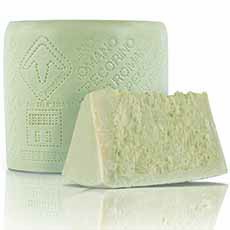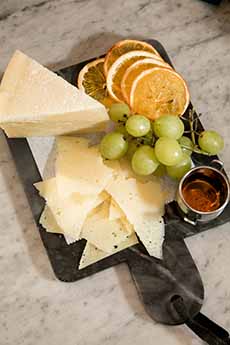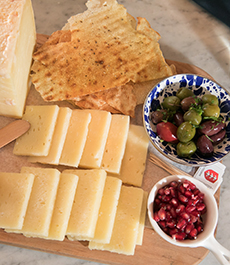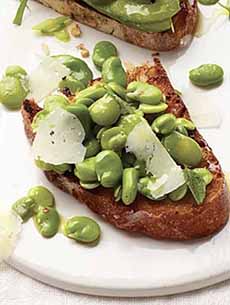TIP OF THE DAY: Pecorino Sheep Cheese
|
WE’RE BULLISH ABOUT SHEEP… …but not just any sheep. We’re crushing on Sarda sheep, the lovely ovine ladies living the luxe life of Italy’s gemstone island, Sardinia (Sardegna in Italian). What they produce is the extraordinary milk that makes the extraordinary Pecorino D.O.P (Denominazione d’Origine Protetta, or Protected Designation of Origin) cheese. D.O.P.* is Italy’s version of France’s Appellation Controlee for wine: It denotes that the product can only be made in certain areas with specific terrain requirements. The designation is a guarantee of cultural heritage and exceptional quality. You’ll find the best of it under the imprint of 3 Pecorini (#3pecorinicheeses). A delicious recipe and the history of Pecorino cheese are below. Sarda sheep (photo #4) graze on herbs and shrubs and breathe the clean Mediterranean air of Sardinia’s valleys and mountains. Their farmers and herders have inherited centuries of ancient techniques that have proved ideal for cheesemaking, resulting in unmistakable flavor (from mellow to tangy) and long-term storage capacity. Trying to describe the multi-level flavor profile of sheep’s milk cheese depends on the changes that occur as it ages. Always, however, you’ll note an edge and complexity (experts call it “sheepiness”) that non-sheep milk cheeses miss out on. If you grate heaps of fresh Parmesan onto your pasta, you’ll get fabulous flavor, but you won’t get that fascinating little tipping point gives Pecorino cheese its unique qualities. Most pecorino cheeses are classified as grana and are granular, hard and sharply flavored. Look for Pecorino Sardo marked D.O.P. at a quality cheese store or counter. The label should state how long the cheese has been aged. Taste-test the different ages of the cheese for comparison. The sharpness depends on the period of maturation, which varies: Fiori Sardo is the finest Pecorino, but substitute Pecorino Romano if you can’t find it. Prep time is 25 minutes, cook time is 20-25 minutes. Ingredients For 4 Servings ________________ †The prosciutto will be salty, so use caution when adding salt to taste. 1. PREHEAT the oven to 375°F. 2. PARBOIL the asparagus in a pot of salted water. Test the asparagus for doneness, but do not overcook (it should be slightly firm to the bite). Drain the asparagus, but save the water it was cooked in. Cut the asparagus into bite-size pieces and set aside. 3. HEAT the olive oil in a medium saucepan over medium heat and brown the prosciutto. Add the onion and sauté until translucent, but not browned. 4. ADD a small amount of water to the pan, lower the heat, and cook about 10 minutes. Add the asparagus pieces. Stir and season to taste with salt and pepper. 5. COMBINE the ricotta, bechamel, and the Fiore Sardo in a medium bowl. Stir in the asparagus and prosciutto mixture. 6. COOK the ziti in the reserved asparagus water until al dente. Remove to a large bowl with a slotted spoon and add the ricotta and bechamel mixture. Toss well until all of the ingredients are combined. 7. POUR the mixture into a buttered baking dish, dot the top with butter, and add some additional grated Fiore Sardo. Bake about 20 to 25 minutes, or until mixture is bubbling. 1. MELT the butter in a small saucepan over medium heat. Whisk in the flour, stirring until you have a smooth white paste. 2. COOK, whisking constantly until mixture is very pale yellow (watch carefully so as not to overcook the flour). Carefully add the hot milk a little at a time, whisking constantly until mixture is smooth and creamy. 3. STIR in the nutmeg, salt, and pepper to taste. — Rowann Gilman Thanks to the Consortium for the Protection of Pecorino Romano Cheese for this history. Few cheeses in the world have such ancient origins as Pecorino Romano. For more than 2000 years, the flocks of sheep that graze freely in the countryside of Lazio and Sardinia have produced the milk from which the cheese is made. A cheese variety of what might be considered the earliest form of today’s Pecorino Romano was first created in the countryside around Rome. Its method of production being described by Latin authors such as Varro and Pliny the Elder about 2,000 years ago [source]. The ancient Romans were fans of Pecorino Romano. It was prized at banquets in the imperial palaces, and its long-term storage capacity made it a staple food for rations when the Roman legions marched. Pecorino Romano was so much in use among the Romans that a daily ration of 27 grams was established for the Legionaries, as a supplement to their bread and farro soup. The cheese was produced in Latium (modern Lazio), the region of central western Italy in which the city of Rome was founded, until 1884. |
|
|
|
Then, due to the city council prohibiting salting the cheese in their shops in Rome, many Roman producers moved to the island of Sardinia, which provided Roman entrepreneurs with a type of soil that was ideal for monoculture farming [source]. Today, the cheese is produced exclusively from the milk of sheep raised on the plains of Lazio and in Sardinia. Most of the cheese is produced on Sardinia. Per D.O.C. law, Pecorino Romano must be made with lamb rennet from animals raised in the same production area. Thus, is not suitable for vegetarians. The processing of sheep’s milk was described by Homer (born sometime between the 12th and 8th centuries B.C.E.) It was codified in the following centuries. Columella (4 C.E. to 70 C.E.), a prominent Roman writer on agriculture, gives a detailed description in his “De re rustica”: “…the milk is generally curdled using lamb’s or kid’s rennet….The milking bucket, when it has been filled with milk, should be kept at a medium heat. Do not let it come near sources of fire…rather keep it well away from fire, and as soon as the liquid is curdled, it should be transferred into baskets or moulds. In fact it is essential that the whey can drain immediately and be separated from the solid matter…. Then when the solid part is removed from the baskets or moulds, it should be placed in a cool, dark place so that it does not go off, on tables as clean as possible, and sprinkled with ground salt so that it can sweat.” *D.O.P., Denominazione d’Origine Protetta is the Italian certification of authenticity of origin. Some other countries in the European Union also use D.O.P. now, including Portugal. See also A.O.C. and D.O. ________________
|
||
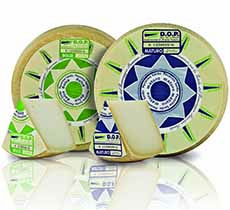 ]
]
